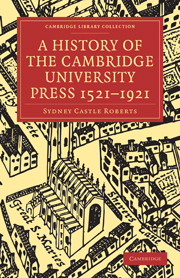Book contents
- Frontmatter
- PREFACE
- Contents
- ILLUSTRATIONS
- BIBLIOGRAPHY
- I JOHN SIBERCH
- II THE CHARTER–THOMAS THOMAS AND THE STATIONERS
- III FROM JOHN LEGATE TO ROGER DANIEL
- IV PRINTERS OF THE COMMONWEALTH AND RESTORATION
- V RICHARD BENTLEY–THE FIRST PRESS SYNDICATE
- VI EIGHTEENTH CENTURY PRINTERS
- VII THE EARLY NINETEENTH CENTURY
- VIII THE LATEST AGE
- APPENDIX
- INDEX
V - RICHARD BENTLEY–THE FIRST PRESS SYNDICATE
Published online by Cambridge University Press: 05 October 2010
- Frontmatter
- PREFACE
- Contents
- ILLUSTRATIONS
- BIBLIOGRAPHY
- I JOHN SIBERCH
- II THE CHARTER–THOMAS THOMAS AND THE STATIONERS
- III FROM JOHN LEGATE TO ROGER DANIEL
- IV PRINTERS OF THE COMMONWEALTH AND RESTORATION
- V RICHARD BENTLEY–THE FIRST PRESS SYNDICATE
- VI EIGHTEENTH CENTURY PRINTERS
- VII THE EARLY NINETEENTH CENTURY
- VIII THE LATEST AGE
- APPENDIX
- INDEX
Summary
In the movement for the revival of Cambridge typography at the end of the seventeenth century the most prominent name is that of Richard Bentley.
The renovation of the University Press (writes his biographer, Monk), which had continued in decay since the Usurpation, was projected by him, and mainly accomplished through his agency. New buildings, new presses, and new types were all requisite; and the University itself being destitute of funds, a subscription for these purposes was procured principally by his exertions; and the deficiency was made up by the Senate borrowing a thousand pounds. The task of ordering types of every description was absolutely committed to his discretion by a grace in very complimentary terms; and the power of attorney given him on this occasion is the most unlimited I recollect ever to have seen.
The reference to the continuous decay of the Press during fifty years savours of exaggeration. The typographical inaccuracies in Field's bibles, it is true, became notorious; but it was Field who built the new printing-house and from 1655 onwards there is no year in which the continuity of book-production is broken.
On the other hand, it is clear that the old system inaugurated by the charter of 1534 had broken down. Under that system the university simply licensed tradesmen (who might, or might not, be members of the university) to print and sell books; and the proper working of the Press was dependent on the capabilities of the individual printer.
- Type
- Chapter
- Information
- A History of the Cambridge University Press 1521–1921 , pp. 77 - 106Publisher: Cambridge University PressPrint publication year: 2009First published in: 1921

